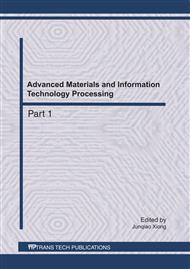[1]
Klank H, Kutter J P and Geschke O: CO2-Laser Micromachining and back-end processing for rapid production of PMMA-based microfluidic systems. Lab on a Chip, Vol. 2(2002), pp.242-246.
DOI: 10.1039/b206409j
Google Scholar
[2]
Snakenborg D, Klank H, Kutter J P: Microstructure fabrication with a CO2 laser system. J. Micromech. Microeng., Vol. 14(2004), pp.182-189.
DOI: 10.1088/0960-1317/14/2/003
Google Scholar
[3]
Ji-Yen Cheng, Cheng-Wey Wei, Kai-HsiungHsu and Tai-Horng Young: Direct-write laser micromachining and universal surface modification of PMMA for device development. Sensors and Actuators B, Vol. 99(2004), pp.186-196.
DOI: 10.1016/j.snb.2003.10.022
Google Scholar
[4]
C K Chung, Y C Lin and G R Huang: Bulge formation and improvement of the polymer in CO2 laser micromachining. J. Micromech. Microeng., Vol. 55(2005), pp.1878-1884.
DOI: 10.1088/0960-1317/15/10/013
Google Scholar
[5]
Dajun Yuan and Suman Das: Experimental and theoretical analysis of direct-write laser micromachining of polymethylmethacrylate by CO2 laser ablation. Journal of applied physics, Vol. 101(2007), pp.249011-249016.
DOI: 10.1063/1.2409621
Google Scholar
[6]
Ting-Fu Hong, Wei-Jhong Ju, Ming-Chang Wu, Chang-Hsien Tai, Chien-Hsiung Tsai and L. F: Rapid prototyping of PMMA microfluidic chips utilizing a CO2 laser. Microfluid Nanofluid, Vol. 9(2010), pp.1125-1133.
DOI: 10.1007/s10404-010-0633-0
Google Scholar
[7]
L. Romoli, G. Tantussi and G. Dini: Experimental approach to the laser machining of PMMA substrates for the fabrication of microfluidic devices. Optics and Lasers in Engineering, Vol. 49(2011), pp.419-427.
DOI: 10.1016/j.optlaseng.2010.11.013
Google Scholar
[8]
J. Paulo Davim, Nuno Barricas, Marta Conceicao and Carlos Oliveira: Some experimental studies on CO2 laser cutting quality of polymeric materials. Journal of materials processing technology, Vol. 198(2010), pp.99-104.
DOI: 10.1016/j.jmatprotec.2007.06.056
Google Scholar
[9]
Fu Jianzhong, Xiang Hengfu and Chen Zichen: Modeling of laser machining on PMMA to fabrication microfluidic chip. Chinese Journal of Mechanical Engineering, Vol. 19(2006).
Google Scholar


